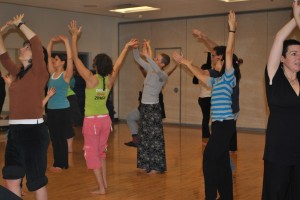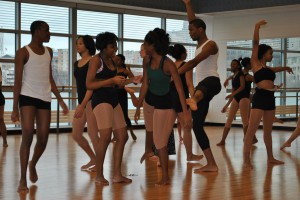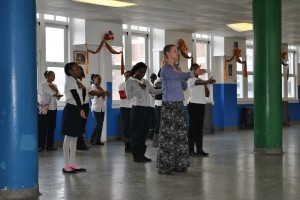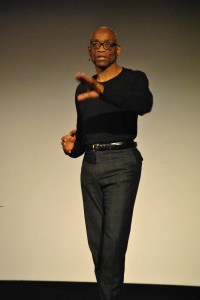Going Gaga for Gaga

Photo: Batsheva Dance Company. The company performs Last Work January 7-8, 2017. Courtesy of the artist.
On January 7-8, Batsheva Dance Company bring their new work Last Work to Ann Arbor. Led by critically-acclaimed artistic director Ohad Naharin, this piece is devised using the Gaga movement language, the movement form for which the company and the director are best known.
Based in Tel-Aviv, Batsheva Dance Company was created by Martha Graham and Baroness Batsheva de Rothschild in 1964. The company has evolved its movement style from the Graham-based technique into the Gaga movement language, integrating emerging Israeli choreographers throughout its lifetime before Ohad Naharin took the helm in 1990.
Bodybuilders with a soft spine
Ohad Naharin created the Gaga movement “language” in the 1990s during his first few years as artistic director at Batsheva. Partially inspired by his observations of existing techniques as well as a non-dancing Batsheva employees request to learn how to dance, Naharin created Gaga in response to the rigid perfectionism that permeates some dance styles. He describes this type of perfectionism as a “deadly burden,” and the antithesis to accessing true movement and physical expression.
All movement stems from sensation in Gaga. Movement is a sensual experience: Dancers learn to love their sweat, the burning of their muscles, and their interior sensory experiences as they move. Gaga teaches dancers and movers to focus on the rhythm of their bodies, not the music. Focusing in this way helps movers find their inner ambition, discover themselves instead of focusing on dance as an external experience based on learned techniques.
Naharin uses Gaga to teach his dancers how to be “body builders with a soft spine.” He works to break dancers free from their technique, which is necessary as a structural component of dance training but also can restrict dancers from finding movements not found or prevalent in particular dance styles. In fact, while creating choreography Naharin discourages dancers from using improvisation, which he says often lures dancers back into their habitual movement patterns.
Gaga comes to the University of Michigan
Naharin’s movement language has spread to dance companies across the world, partly because of Batsheva alumni like Bsomat Nossan. Nossan was a guest lecturer in the Dance department at the University of Michigan in the Winter 2016 semester.
We spoke with U-M BFA Dance students Johnny Matthews and Kasia Reilly, both students who have studied with Ohad Naharin or his company members.
Reilly says that Gaga is not so much a technique as a “vehicle to dance with; it increases sensitivity to the conversation between one’s inner kinesthetic experience and the external feedback one receives while dancing.” For Matthews, Gaga is an essential part of his dancing education. Matthews decided to study with Ohad Naharin and Batsheva after seeing L-E-V Dance Company, a dance troupe started by a Batsheva alumna Sharon Eyal. (The company performed at the Power Center in Ann Arbor as part of the 2015-16 UMS Season.) “I was amazed by the raw power these dancers had,” he says. “The way they could manipulate their bodies into unimaginable shapes, then return to a neutral state in an instant.” Gaga was instrumental in helping Matthews unlock the opportunities within his body, to move in ways he never did before by looking inward instead of simply “putting movement onto [the] body.” This method helped Matthews to find new ways to approach movement even in technical or shape-driven styles like ballet.
According to Reilly and Matthews, Gaga sessions can vary widely from instructor to instructor. The rules are simple: “No mirrors, no late entry, no one can watch class, and you never stop moving,” says Matthews. Gaga movement is centered around the idea of “floating” through space, meaning your body is unencumbered by gravity and thus is available to move in limitless ways. These sessions involve exercises with instructions such as “draw circles with different body parts,” “imagine the floor is getting hot,” or “become a string of spaghetti in hot water,” and other sensory-based exercises to help dancers access unfamiliar movements. Gaga teachers encourage students not to miss class because “Gaga class is all about building tasks on top of each other to push the limits of how much information your brain can process at one time,” Matthews says. If students are feeling slow or low-energy, they may work at their own pace, working at “40%, 30%, 20%, or float,” but they must never be stagnant.
Gaga movement language creates a way for both dancers and non-dancers to access new movements. According to Matthews, Naharin was severely injured at the time he created Gaga and devised the language in part to rehabilitate himself. Gaga pedagogy is broken into Gaga Dancers and Gaga People. Non-dancers are actively encouraged to explore the technique, and Gaga People classes are created to train people to be better attuned to their own body and their own needs.
Naharin’s influence can be felt globally. Batsheva alumni such as above-mentioned Sharon Eyal (founder of L-E-V Dance Company), Andrea Miller (Gallim Dance Company), and Daniele Agami (Ate9) have used their artistic prowess to spread Gaga throughout the world. Ohad Naharin’s movement language has become one of the most popular contemporary dance philosophies of today. “I would call it almost uncommon now to meet a dancer who hasn’t taken at least one Gaga class before,” says Reilly, adding “the rawness, athleticism, and sexiness of his works are addictive to watch,” and the success of his company has lead to an uptick in mindfulness-based somatic movement work in the dance community.
The opportunity to see the company where it all began awaits. See Batsheva Dance Company’s Last Work in Ann Arbor January 7-8, 2017.
Keepin’ up with the Joneses: BTJAZ Dance Co. in Residence
When asked to write this blog, I have to admit, I was more than a little anxious. I was stoked but I couldn’t shake the unnerving feeling about doing something way outside the job description. I was handed the opportunity to leave my usual post in the UMS Ticket Office to work closer than I ever have with our artists. I was to follow the Bill T. Jones/Arnie Zane Dance Company during their educational residency with UMS.
Day One: Masterclass at Dance Theater Studio, Ann Arbor
As I climbed the stairs to the studio I saw that BTJAZ Dance Company Education Director Leah Cox and dancer Talli Jackson had already arrived. About 15 high school ballet dancers streamed into the studio excited for a change from their usual routine. In the beginning half of class, Leah and Talli led an exploration of movement, Bill T. style. Leah had the class move through different levels and space stressing the importance of creating movement that is aware, yet unrestrained. The idea is that, in dance, your mind is as much of an active participant as your body. In actively engaging both you can evoke dance based on specific ideals, like the girls later learned through creating dance inspired by their own heroes. It was amazing to see Leah communicate this idea to the teen dancers, who then translated this concept in their own original movements. The same process was used to create Fondly Do We Hope…Fervently Do We Pray, the piece the Bill T. Jones/Arnie Zane Dance Co. would perform later that week. Check out my video clip and see the Dance Theater Studio class at work.
So We Think You Can Dance, Dance Workshop for the Ann Arbor Community
After watching the first master class, I was hooked. So, that evening, instead of observing the community dance workshop, So We Think You Can Dance, at the Ann Arbor YMCA I decided I had to participate—Yikes!! As a novice dancer, I was comforted to see the wide range of participants brave enough to explore movement with me, and as an UMS staffer I was proud to see such a fantastic turnout! Leah eased into the class with a warm-up called the developmental patterns. While we breathed, curled, and twisted, Leah explained that through these movements we were reprogramming our bodies, reteaching ourselves to create movement, not as coordination, but as what we do naturally as human beings. We then paired off to discover new shapes. While impulsively traveling through space from shape to shape, I reminded myself to maintain awareness of how my body was moving. Was it as effortless or beautiful as Leah and Talli made it look? I’ll leave you to decide…
Day Two: Detroit’s Paul Robeson Academy and Cass Tech High School
The afternoon spent visiting Paul Robeson Academy and Cass Tech High School was memorable and eye opening for me. We’ve all heard about the financial state of the Detroit Public School system and the bad rap the schools generally receive. In spite of the obvious need for more resources and more classroom space, I couldn’t help but notice the excitement of the students at Paul Robeson Academy or the youthful talent of the Cass Tech students. What I thought was just an ordinary day at these schools changed when I saw how eagerly the students received Leah and Talli. After watching the students’ earnest participation during the workshops, I felt really privileged to be part of their learning experience with the arts. I’m sure Leah and Talli felt just the same.
Day Three: Penny W. Stamps Distinguish Speakers Series, Michigan Theater
As the performance date of Fondly Do We Hope…Fervently Do We Pray neared I began to wonder, what kind of man is Bill T. Jones? Sure, I knew his methods behind creating the piece but what were his intentions, his message? Fingers crossed and eager to find out more, I went to his lecture–part of the Penny Stamps Distinguished Speakers Series–in the Michigan Theater. Bill spoke to a full house and shared his philosophy on movement, the words of Abraham Lincoln and Walt Whitman, as well as excerpts from the performance. He described his own personal relationship to Lincoln as having evolved. Starting with a child’s unconditional love for a legendary figure, torn down in young adulthood to a man he abhorred, and settling as a hero and inspiration as an adult. Losing faith in our childhood heroes is easy enough to understand, and Bill’s new vision of Lincoln was an inspiration. By the end of the lecture Bill asked us to examine his work as pieces of a puzzle, fit them together as we will, and invited us to reclaim Lincoln. I decided that Bill was prodding us to perceive every motion, every song, even everyday life, and then, ultimately, encouraging us to determine reality on our own terms.
I’d like to say I left that lecture with more answers than questions. Yet, even after the workshops, lectures, the Q & As, and performances, I still find myself stirring from the music and movement of Fondly Do We Hope…Fervently Do We Pray. Following the Bill T. Jones/Arnie Zane Dance Company’s residency with UMS was such a rewarding endeavor for me personally because I was able to see another side of UMS. My daily interactions with the artists coming through UMS’ auspices are limited to the mentioning of their names over the phone. After spending the week attending the residency events I was not only amazed at the number of educational opportunities planned to connect with artists and enrich the community, but also at how invested I had became inthe residency overall.
For more photos from the events I’ve mentioned as well as other events including the BTJAZ Dance Co. Youth Performance and masterclasses with Wayne State University and University of Michigan please check out my slideshow.






